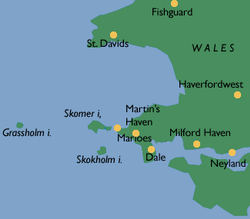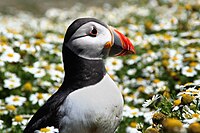Skomer
| Skomer Welsh: Ynys Sgomer | |
 A map showing Skomer Island | |
|---|---|
| Location | |
| Grid reference: | SM725093 |
| Area: | 1.1 square miles |
| Data | |
Skomer is an island off the coast of Pembrokeshire, one of a chain lying within a mile off the Pembrokeshire coast and separated from the mainland by the treacherous waters of Jack Sound. Skomer Island measures approximately a mile and a half north-south and two miles east-west.
After the war, the owner had offered the West Wales Field Society, now The Wildlife Trust of South and West Wales, the opportunity to make a survey of Skomer which was accepted and the Skomer opened for visitors from April 1946.[1] It was last permanently inhabited by the Codd family (all year round) in 1950, and is known for its stone circle, standing stone and remains of prehistoric houses, as well as for its abundant wildlife. Skomer is a National Nature Reserve, a Site of Special Scientific Interest and a Special Protection Area. Much of Skomer has also been designated an Ancient Monument. It is surrounded by a Marine Nature Reserve. It is managed by the Wildlife Trust of South and West Wales.
Contents
Wildlife
Skomer is best known for its large breeding seabird population, including Manx Shearwaters, Guillemots, Razorbills, Great Cormorants, Black-legged Kittiwakes, Atlantic Puffins, European Storm-petrels, Shags, Oystercatchers and gulls, as well as birds of prey including Short-eared Owls, Common Kestrels and Peregrine Falcons.
The island is also home to Grey Seals, Common Toads, Slow-worms, a breeding population of Glow-worms and a variety of wildflowers. Harbour Porpoises occur in the surrounding waters. The Skomer Vole, a sub-species of Bank Vole, is endemic to the island.
Atlantic Puffin
There are over 10,000 breeding pairs of Puffins on Skomer and Skokholm Islands, making them one of the most important Puffin colonies in Britain. They arrive in mid-April to nest in burrows, many of which have been dug by the island's large rabbit population. The last Puffins leave the island by the second or third week in July. They feed mainly on small fish and Sand Eels; often Puffins can be seen with up to a dozen small eels in their beaks. After a period of declining numbers between the 1950s and 1970s, the size of the colony is growing again at 1–2% a year (as of 2006). By 2004, there were numerous Puffin burrows on the island and adults flying back with food run across the walkways oblivious to the tourists.
Manx Shearwater
With an estimated 128,000 breeding pairs, Skomer and sister island Skokholm are the world's most important breeding site for these birds, the numbers comprising over half the world population of the species. They usually nest in rabbit burrows, a pair reportedly using the same burrow year after year.
Shearwaters are not easy to see as they come and go at dusk, but a CCTV camera in one of the burrows allows subterranean nesting activity to be seen on the screen in Lockley Lodge on the mainland at Martin's Haven. The remains of Shearwaters killed by the island's population of Greater Black-backed Gulls can also be seen.
The Manx Shearwater has a remarkable life. After fledging the young birds migrate to the South Atlantic off the coast of Brazil. They remain there at sea for five years before returning to breed on their natal island. On their return they navigate back to within a few yards of the burrow in which they were born. As they are ungainly and vulnerable on the land, they leave their burrows at dawn for the fishing grounds some 30 miles out to sea, not returning until dusk. Thus they attempt to avoid the gulls to which they would fall easy prey.
Skomer Vole
Skomer has one unique mammal: the Skomer Vole (Clethrionomys glareolus skomerensis), a distinct form of the Bank Vole. The lack of land-based predators on the island means that the bracken habitat is an ideal place for the vole, with the population reaching around 20,000 during the summer months. Then the resident Short-eared Owls may be seen patrolling the areas close to the farmhouse in the centre of the island for voles to feed their young.
Access
Boats sail to Skomer from Martin's Haven on the mainland, a 15–20 minute trip every day except Monday (Bank Holiday Mondays excepted) from April to October between 10am and 12 noon (actual times may vary). Return sailings are from 3 pm but the boatman will advise on the day. There are limits on the number of people allowed to visit the island (currently 250 a day). Advance booking is not permitted and reservations are strictly on a first come, first served basis at the local shop at Martin's Haven and long queues can develop early each morning.
Areas open for visitor access are restricted to pathways. The Neck, an eastern area connected only by a narrow isthmus, is entirely out of bounds to visitors.
In 2005–06, there was a renovation project of the farm buildings which included the old barn for improved overnight visitor and research accommodation, the volunteers' quarters were rebuilt and the warden's house at North Haven was also rebuilt. Solar power provides hot water and a small amount of electricity for lighting. Self-catering visitor accommodation is now available from April to October.
Pictures
Outside links
| ("Wikimedia Commons" has material about Skomer) |
- Wildlife Trust of South and West Wales
- Pictures of Skomer Island and the area on Geograph.co.uk
- Skomer Island
- Birds at Skomer Island
References
- ↑ Island of Skomer, John Buxton and Ronald Lockley, Staples Press, 1950.





